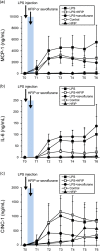Insight into the beneficial immunomodulatory mechanism of the sevoflurane metabolite hexafluoro-2-propanol in a rat model of endotoxaemia
- PMID: 25925908
- PMCID: PMC4557383
- DOI: 10.1111/cei.12648
Insight into the beneficial immunomodulatory mechanism of the sevoflurane metabolite hexafluoro-2-propanol in a rat model of endotoxaemia
Abstract
Volatile anaesthetics such as sevoflurane attenuate inflammatory processes, thereby impacting patient outcome significantly. Their inhalative administration is, however, strictly limited to controlled environments such as operating theatres, and thus an intravenously injectable immunomodulatory drug would offer distinct advantages. As protective effects of volatile anaesthetics have been associated with the presence of trifluorinated carbon groups in their basic structure, in this study we investigated the water-soluble sevoflurane metabolite hexafluoro-2-propanol (HFIP) as a potential immunomodulatory drug in a rat model of endotoxic shock. Male Wistar rats were subjected to intravenous lipopolysaccharide (LPS) and thereafter were treated with HFIP. Plasma and tissue inflammatory mediators, neutrophil invasion, tissue damage and haemodynamic stability were the dedicated end-points. In an endotoxin-induced endothelial cell injury model, underlying mechanisms were elucidated using gene expression and gene reporter analyses. HFIP reduced the systemic inflammatory response significantly and decreased endotoxin-induced tissue damage. Additionally, the LPS-provoked drop in blood pressure of animals was resolved by HFIP treatment. Pathway analysis revealed that the observed attenuation of the inflammatory process was associated with reduced nuclear factor kappa B (NF-κΒ) activation and suppression of its dependent transcripts. Taken together, intravenous administration of HFIP exerts promising immunomodulatory effects in endotoxaemic rats. The possibility of intravenous administration would overcome limitations of volatile anaesthetics, and thus HFIP might therefore represent an interesting future drug candidate for states of severe inflammation.
Keywords: anaesthesia; fluorinated carbon groups; inflammation; interleukin; sepsis.
© 2015 British Society for Immunology.
Figures







Similar articles
-
Sevoflurane attenuates systemic inflammation compared with propofol, but does not modulate neuro-inflammation: A laboratory rat study.Eur J Anaesthesiol. 2017 Nov;34(11):764-775. doi: 10.1097/EJA.0000000000000668. Eur J Anaesthesiol. 2017. PMID: 28759530
-
Propolis derivatives inhibit the systemic inflammatory response and protect hepatic and neuronal cells in acute septic shock.Braz J Infect Dis. 2011 Jul-Aug;15(4):332-8. Braz J Infect Dis. 2011. PMID: 21861003
-
Pogostone suppresses proinflammatory mediator production and protects against endotoxic shock in mice.J Ethnopharmacol. 2014 Nov 18;157:212-21. doi: 10.1016/j.jep.2014.09.023. Epub 2014 Sep 26. J Ethnopharmacol. 2014. PMID: 25256685
-
Clinical review: immunomodulatory effects of dopamine in general inflammation.Crit Care. 2004 Dec;8(6):485-91. doi: 10.1186/cc2879. Epub 2004 Jun 3. Crit Care. 2004. PMID: 15566620 Free PMC article. Review.
-
Human endotoxemia as a model of systemic inflammation.Curr Med Chem. 2008;15(17):1697-705. doi: 10.2174/092986708784872393. Curr Med Chem. 2008. PMID: 18673219 Review.
Cited by
-
Hexafluoroisopropanol decreases liver ischemia-reperfusion injury by downregulation of high mobility group box-1 protein.Pharmacol Res Perspect. 2022 Dec;10(6):e01027. doi: 10.1002/prp2.1027. Pharmacol Res Perspect. 2022. PMID: 36404629 Free PMC article.
-
Volatile Anesthetic Sevoflurane Precursor 1,1,1,3,3,3-Hexafluoro-2-Propanol (HFIP) Exerts an Anti-Prion Activity in Prion-Infected Culture Cells.Neurochem Res. 2021 Aug;46(8):2056-2065. doi: 10.1007/s11064-021-03344-8. Epub 2021 May 27. Neurochem Res. 2021. PMID: 34043140 Free PMC article.
-
Multifunctional and biodegradable self-propelled protein motors.Nat Commun. 2019 Jul 18;10(1):3188. doi: 10.1038/s41467-019-11141-9. Nat Commun. 2019. PMID: 31320630 Free PMC article.
-
The volatile anesthetic sevoflurane reduces neutrophil apoptosis via Fas death domain-Fas-associated death domain interaction.FASEB J. 2019 Nov;33(11):12668-12679. doi: 10.1096/fj.201901360R. Epub 2019 Aug 30. FASEB J. 2019. PMID: 31513427 Free PMC article.
-
Isoflurane vs. propofol for sedation in invasively ventilated patients with acute hypoxemic respiratory failure: an a priori hypothesis substudy of a randomized controlled trial.Ann Intensive Care. 2022 Dec 20;12(1):116. doi: 10.1186/s13613-022-01090-w. Ann Intensive Care. 2022. PMID: 36538243 Free PMC article.
References
-
- Lagu T, Rothberg MB, Shieh MS, Pekow PS, Steingrub JS, Lindenauer PK. Hospitalizations, costs, and outcomes of severe sepsis in the United States 2003 to 2007. Crit Care Med. 2012;40:754–61. - PubMed
-
- Gaieski DF, Mikkelsen ME, Band RA, et al. Impact of time to antibiotics on survival in patients with severe sepsis or septic shock in whom early goal-directed therapy was initiated in the emergency department. Crit Care Med. 2010;38:1045–53. - PubMed
-
- Dellinger RP, Levy MM, Rhodes A, et al. Surviving sepsis campaign: international guidelines for management of severe sepsis and septic shock: 2012. Crit Care Med. 2013;41:580–637. - PubMed
-
- Landoni G, Fochi O, Tritapepe L, et al. Cardiac protection by volatile anesthetics. A review. Minerva Anestesiol. 2009;75:269–73. - PubMed
-
- Beck-Schimmer B, Breitenstein S, Urech S, et al. A randomized controlled trial on pharmacological preconditioning in liver surgery using a volatile anesthetic. Ann Surg. 2008;248:909–18. - PubMed
Publication types
MeSH terms
Substances
Grants and funding
LinkOut - more resources
Full Text Sources
Other Literature Sources
Molecular Biology Databases
Research Materials

